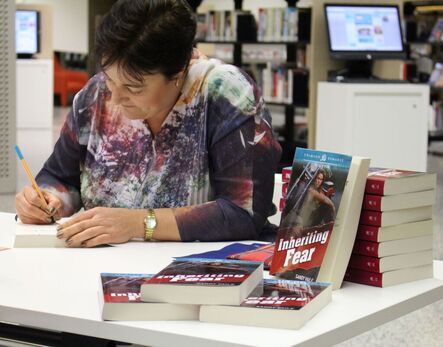Sandy Vaile's Blog, page 3
August 24, 2022
Withholding Too Much Information Kills Story Tension
The best way to add more tension to a story Regardless of the length or genre of a story, creating tension is essential to holding readers' attention.
But what is the best way to add more tension to a story?
Often I see aspiring authors withholding information in an effort to be vague and cryptic, which only serves to frustrate readers instead of engage them. Perhaps surprisingly, it is the act of proving information to the reader — be it in the right place and quantity — that makes them curious ...
But what is the best way to add more tension to a story?
Often I see aspiring authors withholding information in an effort to be vague and cryptic, which only serves to frustrate readers instead of engage them. Perhaps surprisingly, it is the act of proving information to the reader — be it in the right place and quantity — that makes them curious ...
Published on August 24, 2022 14:28
July 20, 2022
Play with Limited Third Person POV
 Purpose The purpose of these exercises is to explore how it feels to write using Third Person Limited Point of View (POV).
Purpose The purpose of these exercises is to explore how it feels to write using Third Person Limited Point of View (POV).
This POV option restricts you to one character’s heart and mind at a time, which gives readers time to engage deeply with that character’s desires and struggles.
Exercise Choose one character whose POV you will explore. Ideally, it will be the character with the most to lose in the scene, so you can fully immerse readers in the emotional drama.
Write a scene showi...
Published on July 20, 2022 16:11
June 18, 2022
Pump Up The Tension in Your Story
How to use uncertainty to keep readers on the edge of their seats.
We are all familiar with being so engrossed in a story that we can’t put it down: the “I’ll just read one more page before bed time” scenario.
Tension is the critical element that keeps readers expectant regardless of the genre, place in the story, or whether a scene is action-packed or reflective. Read on to find out how to increase uncertainty and eek it out for as long as possible, to keep readers on the edge of their seats i...
We are all familiar with being so engrossed in a story that we can’t put it down: the “I’ll just read one more page before bed time” scenario.
Tension is the critical element that keeps readers expectant regardless of the genre, place in the story, or whether a scene is action-packed or reflective. Read on to find out how to increase uncertainty and eek it out for as long as possible, to keep readers on the edge of their seats i...
Published on June 18, 2022 20:47
June 7, 2022
How to Leverage Character Development for Authentic Stories
Providing readers with truly memorable stories requires complex and authentic characters, but to provide the kind of meaningful character traits and motivations that keep readers intent throughout a story and pondering its characters long after they close a book, you need to go much deeper than the standard Character Profile checklist.
The trouble is, deficient characters lead to weak stories. So, it's not enough to figure out where they came from, you need to make their thoughts and actions rele...
The trouble is, deficient characters lead to weak stories. So, it's not enough to figure out where they came from, you need to make their thoughts and actions rele...
Published on June 07, 2022 22:34
January 12, 2022
The Relationship Between Point of View and Perspective
The subtleties of story Point of View Are you sometimes bamboozled by all of the choices and subtleties of story Point of View (POV)?
You’re not alone. POV is one of the most common errors in fiction manuscripts and even after reading explanations, authors are often still unclear. Should they choose first person, second person, limited third person or omniscient? Which one is right for their story? The mind boggles.
Today we’re going to explore the difference between Point of View and Perspectiv...
You’re not alone. POV is one of the most common errors in fiction manuscripts and even after reading explanations, authors are often still unclear. Should they choose first person, second person, limited third person or omniscient? Which one is right for their story? The mind boggles.
Today we’re going to explore the difference between Point of View and Perspectiv...
Published on January 12, 2022 05:30
December 19, 2021
Is Treating Writing Like a Business Holding You Back?
Have you published a book yet?  You may have heard over and over again that you need to treat your fiction writing like a business or you’ll never be a successful author, but what you don’t often hear is that doing that could be the very thing holding you back.
You may have heard over and over again that you need to treat your fiction writing like a business or you’ll never be a successful author, but what you don’t often hear is that doing that could be the very thing holding you back.
Say what?
If you haven’t had your first book published yet, then I believe focusing on the business of writing is wasting writing time, and we all know what a precious resource time is.
Building a platform, blogging and posting on social ...
 You may have heard over and over again that you need to treat your fiction writing like a business or you’ll never be a successful author, but what you don’t often hear is that doing that could be the very thing holding you back.
You may have heard over and over again that you need to treat your fiction writing like a business or you’ll never be a successful author, but what you don’t often hear is that doing that could be the very thing holding you back.Say what?
If you haven’t had your first book published yet, then I believe focusing on the business of writing is wasting writing time, and we all know what a precious resource time is.
Building a platform, blogging and posting on social ...
Published on December 19, 2021 15:30
Character Experiences in Deep Point of View
Immersive Deep Point of View (POV)  Characters experience the story world through raw visceral and intellectual information that comes at them from other characters and their environment, but how does that translate onto the page?
Characters experience the story world through raw visceral and intellectual information that comes at them from other characters and their environment, but how does that translate onto the page?
When you’re writing in Limited Third Person POV, moving into Deep POV draws readers even closer to the character by removing any trace of the author.
This has the benefit of enabling readers to experie...
 Characters experience the story world through raw visceral and intellectual information that comes at them from other characters and their environment, but how does that translate onto the page?
Characters experience the story world through raw visceral and intellectual information that comes at them from other characters and their environment, but how does that translate onto the page?When you’re writing in Limited Third Person POV, moving into Deep POV draws readers even closer to the character by removing any trace of the author.
This has the benefit of enabling readers to experie...
Published on December 19, 2021 15:04
July 10, 2021
The Pressure Cooker of Suspense
I believe suspense is for every story, no matter the genre. It’s the ideal tool to compel readers to keep turning pages all the way to the end, by creating real emotional tension.
What is suspense?
Remember back to a book you just couldn’t put down. More than likely, the author made you worry about the character, and be apprehensive about the outcome of conflicts. You might have had clammy palms, a racing heart, fidgeted, or literally sat at on the edge of your seat, desperate to know what happen...
What is suspense?
Remember back to a book you just couldn’t put down. More than likely, the author made you worry about the character, and be apprehensive about the outcome of conflicts. You might have had clammy palms, a racing heart, fidgeted, or literally sat at on the edge of your seat, desperate to know what happen...
Published on July 10, 2021 23:14
January 20, 2021
How to Decide When to Show or Tell
Deciding when to show and when to tell We know “show don’t tell” is a vital concept because it is constantly drilled into writers, but the truth is, the application is subtle, and therefore often difficult. How the heck do you decide which technique is most appropriate in each instance?
Well, I’m going to provide you with a simple process to help you choose the best way to go, so you can be confident that you are using showing and telling in a way that is going to best suit your story and engag...
Well, I’m going to provide you with a simple process to help you choose the best way to go, so you can be confident that you are using showing and telling in a way that is going to best suit your story and engag...
Published on January 20, 2021 20:50
November 9, 2020
First Chapter Responsibilities: What your story opening needs to achieve
This article originally appeared on the Savvy Authors blog 20/06/20. First chapters are POWERFUL First chapters are POWERFUL. They can stop a shopper from casually flicking through the pages to see how the story ends and a publisher from tossing it in the slush pile bin. Readers are searching for a story beginning that grabs their attention, surprises them and makes them curious to the point of desperation to know what will happen next.
But how can you possibly do this in such a short space? I...
But how can you possibly do this in such a short space? I...
Published on November 09, 2020 18:54



